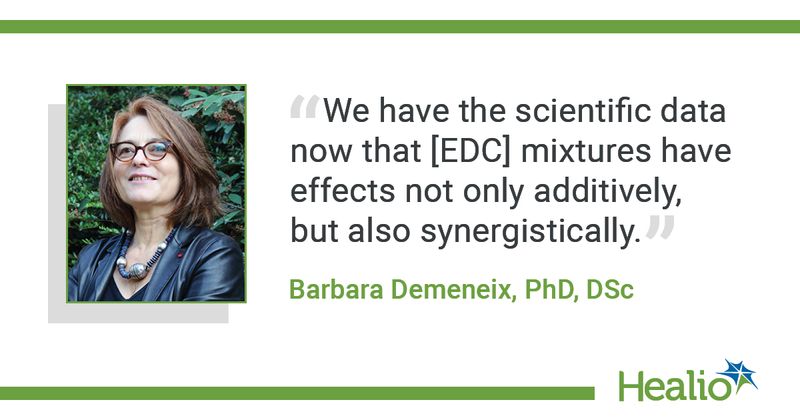European strategy aims to rein in EDC exposures
The European Commission this month unveiled their new chemicals strategy for sustainability, designed to protect the public from exposure to endocrine-disrupting chemicals and their health effects.
The chemicals strategy, part of the European Green Deal, is designed to be the foundation for the biggest update to Europe’s chemical regulations in more than a decade. The chemical strategy commits to a hazard identification for EDCs, including strict measures to prevent their use in consumer products. The strategy also calls for stricter data requirements for EDCs across all relevant legislation and to accelerate the development and adoption of better test methods. In a statement, the Endocrine Society praised the new strategy, and urged “further details and concrete actions” to protect public health.

Healio spoke with Barbara Demeneix, PhD, DSc, chair of the Endocrine Society’s EDC advisory group, about the latest push in Europe to assess EDCs, the risks of combination chemicals and how endocrinologists can become better advocates to rein in EDC use in the United States.
What is the European Green Deal, and how does this new chemical strategy fit into it?
Demeneix : The European Green Deal is an action plan to make the European economy more sustainable and resilient. The goal is to become a sustainable, climate neutral and circular economy by 2050. The chemical strategy is designed to close loopholes in current regulation.
With Remy Slama, PhD, I recently wrote a report for the European parliament and we underlined that there are too many silos and categories where endocrine disruptors could be regulated — or not regulated. We have pesticides, biocides, toys, cosmetics, consumer products, food contact materials, etc. Each of these are classified according to their specific regulations. The Chemical Strategy proposes that once a substance is assessed, if it is considered an endocrine disruptor in any assessment, then it becomes banned across all product categories. This is especially relevant for consumer products, where there is a high risk for human exposure.
The European Commission highlights evaluating “unintentional mixtures” of EDCs. What does this mean, and what might be the endocrine effects of combination chemicals?
Demeneix : We know that some mixtures are intentional. When you buy a cosmetic, you have a list of ingredients on the bottle or label, so you know, theoretically, what is in it. You can also have, for example, a pregnant women who is exposed to multiple chemicals, such as pesticides, food additives, and even the air she is breathing, and at the same time putting on personal care products. These combinations can result in a buildup of chemicals within her body. We know this combined exposure scenario exists. Research shows that a group of ten chemicals might not have an effect individually, but when put together, they do. These exposures to endocrine disruptors have been linked with neurodevelopmental disease, cancers, reproductive cancers in particular, infertility and other reproductive health problems and metabolic disorders and cardiovascular disease. We have the scientific data now that mixtures have effects not only additively, but also synergistically.
This new European strategy also prioritizes PFAS chemicals. Can you outline the risks of PFAS chemicals, how common they are in the U.S., and the effort here to reduce their use?
Demeneix : Perfluoroalkyl and polyfluoroalkyl substances, or PFAS, are persistent, especially the older ones. The CDC shows widespread PFAS exposure in the American population. The legacy PFAS chemicals are a big problem and are linked to many health conditions, including high cholesterol and thyroid function problems. They also reduce immune response. This is exceedingly important during the COVID-19 pandemic. Reduced immune response can exacerbate the effects of COVID-19.
Currently, there is no overall hazard category for chemical strategy in the U.S. It is always been based on individual bills. The Endocrine Society has challenged the FDA’s stance on the cumulative mixture effects of EDCs, such as PFAS. The biggest difference between European and American regulations is in the U.S., regulations are based on risk-based exposure, which doesn’t take into account chronic exposures. In Europe, regulations are based on hazard-based exposure. This is the fundamental difference: hazard vs. risk. When we are talking about chronic exposures, we also need to take into account epigenetic effects. A recent study presented earlier this year showed that exposure to PFAS during pregnancy can influence obesity in granddaughters two generations later. Even temporary exposures in utero can lead to epigenetic effects that are seen 50 years later. This is not taken into account when we look at a risk-based assessment.
How can endocrinologists learn more and become more involved in efforts to regulate EDCs?
Demeneix : In 2019, the Endocrine Society’s EDC Advisory Group developed resources that would help endocrinologists answer questions about EDCs and facilitate evidence-based discussions with their patients. This led to the creation of a series of short videos, which follow from the science presented in the Endocrine Society’s scientific statements on EDCs.
Topics include an introduction to EDCs, endocrine disruptors and metabolic disorders, and helping your patients limit EDC exposures. People who want to learn more can visit the Endocrine Society’s “Let’s talk EDCs” video links available at www.endocrine.org/topics/edcs, which is designed for health care providers and their patients.
Endocrine Society members in the European Union can visit www.endocrine.org/advocacy/take-action to learn how they can become advocates. For U.S. members, lobby the FDA. They can become rational lobbyists. As I often say, getting involved makes you feel that you are actually doing something constructive.
References:
Chemicals strategy for sustainability towards a toxic-free environment. Available at: https://ec.europa.eu/environment/pdf/chemicals/2020/10/Strategy.pdf. Accessed: Oct. 22.
Cohn BA, et al. SAT-LB132. The Endocrine Society Annual Meeting; 2020 (virtual meeting).
For more information:
Barbara Demeneix, PhD, DSc, can be reached at barbara.demeneix@mnhn.fr; Twitter: @BDemeneix.
